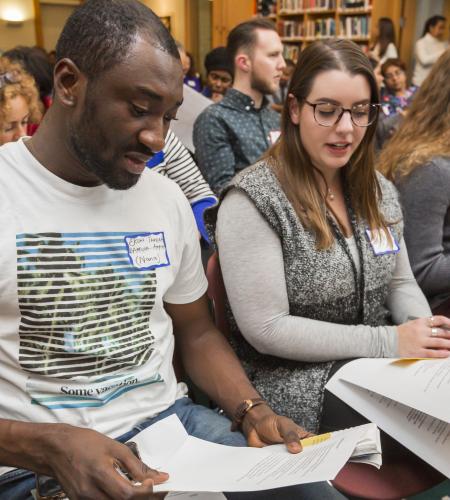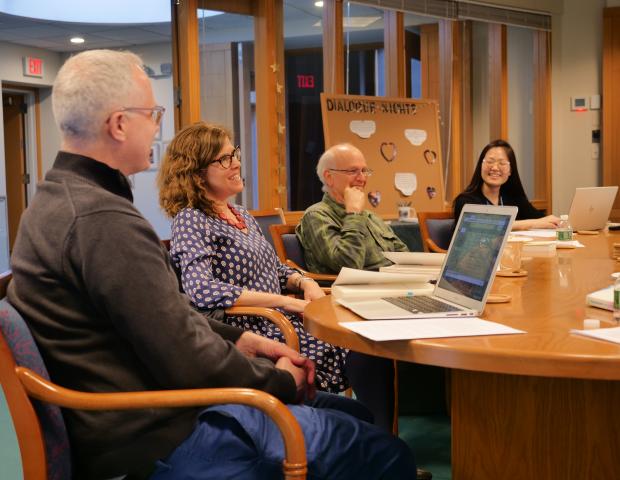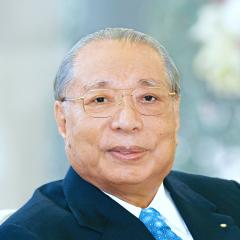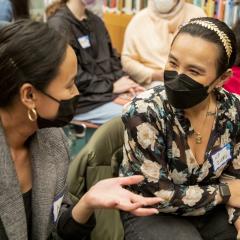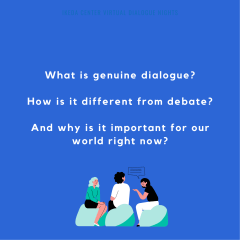Steve Cohen: Always Surprised
Like Donahue-Keegan, Steve Cohen began experimenting with dialogue in the classroom for practical reasons. A young teacher at a “super-progressive school,” he was tasked with teaching history to the same group of students for three hours per day. He pretty quickly figured out that he couldn’t simply talk at them for three hours and they couldn’t listen that long either. Before long “I realized I had to teach differently; it was from practicality that I began to teach differently, and recognize what they were bringing to the conversation.” Part of teaching differently meant moving away from the model of history education in which students read a textbook and then answer preset questions about what they have read. When he went home early on and fell asleep reading the assignment he had just given them he knew something had to change!
A veteran teacher of many decades’ experience, Dr. Cohen observed that “the longer I taught, the less I was bound by content, which I found sort of surprising” adding that content is still important. “But the more I taught,” said Cohen, “I realized it was about getting kids to think about what they knew already, and what they could learn from each other, as well as from me. And I wasn’t trying to abdicate the idea that I might know more than them, just that I didn’t know everything.”
Cohen then shared a couple of his current lessons designed to elicit students’ own thinking and to engage critically with it. Earlier that day he asked students in his education course for undergraduates, School and Society, to envision their ideal high school. Here’s what happened: “They get the budget of Boston Public School, and they’re responsible for curriculum, rules, regulations, how the principal is going to solve puddles [referring back to Steve Gould’s narrative].” Expecting to spend just a few minutes on schedules, they spent an hour and fifteen minutes! Why? “The kind of schedules you arrive at actually tells you how you think people learn, what you think they should learn,” said Cohen. And so students spent the whole time dialoguing about the choices they made, why some things were in, why some things were out, and so on.
As a related inquiry, Dr. Cohen always waits until late in the semester to pose this simple question to students: What is smart? As they think about multiple intelligences they begin to question their own schooling in the sense of no longer taking for granted the choices behind the education they received. This impacts what they think schooling should be in general and what should guide their own ideal high school.
Cohen concluded, saying, “I guess I can keep teaching because I’m always surprised by what comes up when people keep talking with each other and what comes out!” He confessed that his vision of classroom teaching and learning isn’t based heavily on any particular theory or pedagogy. Rather, it is based on experience, which has taught him that listening is the key to it. “So often we’re taught that teaching is talking and listening is learning.” But the truth, he said, is “that so much of teaching is listening.”
Round Two: Other Angles and Levels
After the round of narratives, each participant was invited to share some reflections based on thoughts that were triggered while listening to the stories of the others. Some spontaneous dialogue fleshed out these reflections at various points.
Jason Goulah opened by talking about the importance of being together in the same space for learning and for dialogue. (This has been on his mind since he soon will be teaching an online course for the first time.) Currently, when Goulah teaches there is no “recapitulation” of what students have been asked to read the night before, nor will students be asked to report on what they read. “Everything is always an open-ended question, pushing them to say more, keep going with that,” he said, adding that the deep goal is “the organic development of ideas.” The thrill is in knowing “this collection of bodies will never be here again,” and that “all of this needs to be here for the full meaning making to happen. That’s why being in the space matters. Dialogue matters.”
Of his goals, Goulah said: “What I want to do is rupture them from their preconceived notions of what school is. I want to move them towards how we understand education in the richest sense,” which is a process of “becoming.” This is why he resonated with Steve Cohen’s point about content not necessarily being the heart of the matter, something borne out in his experience as a former teacher of high school Japanese and Russian. He shared how he often would “get emails and calls from students saying ‘I apologize I don’t remember anything about Japanese but I really learned a lot about how to view the world, how to view myself, how to engage difference, and I’m really happy that’s what I took from school.’” This, said Dr. Goulah, is the difference between making our goal to simply “do school” as opposed to engaging in “what Daisaku Ikeda would call human education.”
Steve Gould’s reflections focused on how essential dialogue is to not just schooling, including that social-emotional aspect, but also is “so important to our society in general. It’s a cornerstone of democracy.” For him, this goes way beyond civics education, which is valuable if rarely taught now, to get into Dewey’s idea of a school being a “workshop” of democracy. “I took all this to heart as a teacher, and as a principal,” he said. There were what might be called “reactive” dialogues of the type he shared in his narrative about two boys getting past their conflict.
But he also focused on proactive conceptions of school as a community in itself that is also part of the larger community. “So as principal, every Friday I had an all school assembly, a town meeting format. And we invited parents, business people, kids — everyone came. It was an opportunity to talk about matters of consequence and what does it mean to be a part of a democratic society, and what is your role in it. I think if we had more of that happening, maybe things would be a little bit better. Now more than ever, those kinds of dialogues really have to happen.”
As for the really difficult dialogues that need to happen, for example about race, Dr. Gould said that because they are so difficult, you have to be that much more intentional about it. “You have to have the confidence to say ‘I’m going to be able to help some way and we’ll come out in a better place,’” Gould said, adding: “Sometimes that happens, and sometimes it blows up.” He said that if you don’t at least try to do this, then the hard issues, such as race, will continue to confront us.
Sharing next, Deborah Donahue-Keegan, said she really resonated with “the ‘puddle’ approach. I love the way Steve talked about the two individuals in conflict and the choice to give them something that they have to puzzle over together. The whole set-up is brilliant. I think about how important that is, puzzling together — wrestling with problems, injustices, or issues.”
The other key resonance for Donahue-Keegan had to do with building relational trust in the classroom. She shared a number of practices she employs to achieve this. First, some “scaffolding” is needed. “In my courses, we spend the first couple of weeks, spilling into the third week, with students writing their autobiographical reflections on their own experiences. Then each student shares their story. We start with some light questions that are playful in a way — that produce that dopamine hit, that warm tone feeling.”
In response to Steve Cohen’s question about what kinds of questions these are, Professor Donahue-Keegan said they really could be anything and that on occasion she thinks them up on the way to class. One effective one is to ask them about “zany” or silly talents they might have. One icebreaker activity that can lead to deeper questions is to have the students arrange themselves according to the order of their birthdays. This gets them talking, getting “to know each other in a safe way.” From here they can move to autobiographical sharing. That’s where students can learn the full range of their backgrounds — from those “from very privileged backgrounds with well-resourced schools” to others “who are from very historically marginalized communities.”
Ultimately, it takes a lot of skill building to have honest conversations. These skills include listening, perspective taking, and not least, “being able to pause” and be aware when you might be “triggered” or “pissed off” or “ashamed,” and so on. Donahue-Keegan’s fundamental stance is that “we all as human beings want to be seen or heard.” As one example of learning to honor one another, she said that her classes lately have emphasized “calling in” instead of “calling out,” inspired by a piece she and her students read by Loretta Ross.
To launch his reflection, Steve Cohen handed out a cartoon from Garry Trudeau called “Street Calculus.” In it, a black man and a white man approach each other on the street. Thought bubbles show the checklists of “risk factors” and “mitigating factors” that each runs through in his head to see how much of a threat the other person poses. “I’ll use this [cartoon],” said Cohen, “fairly early in the semester as a way to talk to each other. I ask: Is this true? Do you do this? And what are your risk factors?” This then gets into discussions about context. In other words, each of us will engage in this activity depending on where we are, especially when we depart from what might be called homogenous safe zones. The way we engage in our risk assessments depends on so many things, he said, for example: “whether you are a man or a woman, or even what kind of man you are in our ‘man up’ culture.”
Dr. Cohen’s goal is to get students to engage in discussion “on the way we make judgments in society, and also how they are making judgments in the classroom.” Some teachers, said Cohen, might use this exercise and conclude that from then on there won’t be any more prejudice in their classroom. But a classroom without prejudice would mean “there are no people!” he said. We’re “all a mix of these,” he added. “But the point is to be able to recognize what we know is a prejudice, versus what we think we know is true, and to get at that difference.”
Asked by moderator Mitch Bogen about his use of primary source materials, Cohen said he starts with the assumption that for many students, “reading and thinking are not linked. And I have to get them to think about the reading. My job as a teacher is to help the student figure out how to use the ‘stuff’ we’re looking at.” Personally, he tries “to use that content in a way to hit their humanity” and also to help them develop the critical “ways of thinking about the world that in the United States of 2019” we’re only going to need more of if we’re “going to have a democracy that works.”
One theme that all of the participants touched on after the round of reflections was how it’s helpful in many respects for the teacher to exhibit some vulnerability in order to create a classroom conducive to openness, a theme central to Cohen’s chapter. One form this takes is for teachers to admit they don’t know everything, as Donahue-Keegan did in her early teaching experience in Jamaica. Another aspect of this is fear of failure. One way to deal with this, said Donahue-Keegan, is simply to admit teachers make mistakes too. Goulah said that for pre-service teachers especially, there is a vulnerability that comes from not knowing how lessons will go. In his case he learned that despite your best efforts at preparation, sometimes you’ll go down “in flames,” and in that case you just “plow through.” The basic fear for new teachers, said Steve Gould, is this: “If I’m human, are they going to walk all over me?” Donahue-Keegan also mentioned how white teachers need to let go of the “fragility” that Robin DiAngelo says afflicts too many white Americans when it comes to race, leading them to be defensive rather than open and reflective during considerations of racial injustice and institutional racism.
Wrapping Up
The discussion concluded with some free-flowing back and forth. Here are a few sound bites. Goulah: With students we often talk about “human-to-human verbal dialogue, but another thing I would do is also warmly invite them to dialogue with nature.” Donahue-Keegan: “While I was listening I thought about that saying ‘think globally and act locally” and thought we could also say ‘think systemically and dialogue locally.’” And finally, this from Steve Cohen: “When you think about schools … schools are never finished. They are always changing: different students, different teachers. And this is the way life is — unlike in our culture where we want everything wrapped up with a bow,” thinking we’ve reached “closure.”
* One of Donahue-Keegan’s favorite tools for helping students develop emotional literacy is Plutchik’s wheel of emotions, which maps out relationships among emotions and the many levels that related emotions function at.
